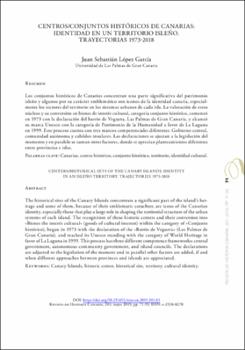Centros/conjuntos históricos de Canarias: identidad en un territorio isleño. Trayectorias 1973-2018
Author
López García, Juan SebastiánDate
2019Abstract
Los conjuntos históricos de Canarias concentran una parte significativa del patrimonio
isleño y algunos por su carácter emblemático son iconos de la identidad canaria, especialmente
los rectores del territorio en los sistemas urbanos de cada isla. La valoración de estos
núcleos y su conversión en bienes de interés cultural, categoría conjunto histórico, comenzó
en 1973 con la declaración del barrio de Vegueta, Las Palmas de Gran Canaria, y alcanzó
su marca Unesco con la categoría de Patrimonio de la Humanidad a favor de La Laguna
en 1999. Este proceso cuenta con tres marcos competenciales diferentes: Gobierno central,
comunidad autónoma y cabildos insulares. Las declaraciones se ajustan a la legislación del
momento y en paralelo se suman otros factores, donde se aprecian planteamientos diferentes
entre provincias e islas. The historical sites of the Canary Islands concentrate a significant part of the island’s heritage
and some of them, because of their emblematic carachter, are icons of the Canarian
identity, especially those that play a large role in shaping the territorial structure of the urban
systems of each island. The recognition of these historic centers and their conversion into
«Bienes the interés cultural» (goods of cultural interest) within the category of «Conjunto
histórico), began in 1973 with the declaration of the «Barrio de Vegueta» (Las Palmas de
Gran Canaria), and reached its Unesco standing with the category of World Heritage in
favor of La Laguna in 1999. This process has three different competence frameworks: central
government, autonomous community government, and island councils. The declarations
are adjusted to the legislation of the moment and in parallel other factors are added, if and
when different approaches between provinces and islands are appreciated.





